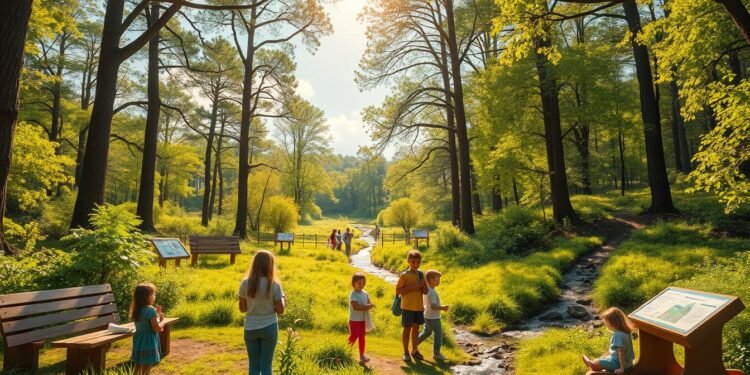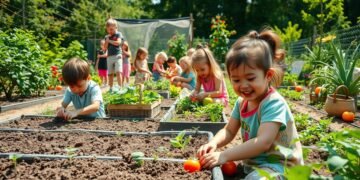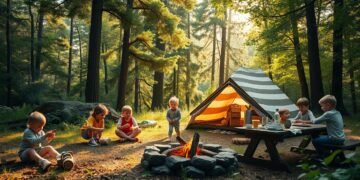Have you ever wondered how spending time in nature can transform the way students learn? With schools increasingly embracing experiential education, the benefits of blending the outdoors with academic skills are becoming undeniable. From boosting creativity to improving focus, the great outdoors offers a unique classroom experience.
This curated list of 10 ideas combines STEM, art, and literacy skills, making them perfect for students of all ages. Whether you’re a parent or an educator, these activities are adaptable for preschoolers to middle schoolers. Plus, they’re designed to be simple yet impactful, ensuring everyone can participate.
Real-world success stories, like environmental schools dedicating 50% of their time to outdoor education, highlight the transformative power of these experiences. Ready to explore how nature can enhance learning? Let’s dive in!
Key Takeaways
- Outdoor education is gaining popularity in schools across the U.S.
- Spending time in nature improves focus, creativity, and physical health.
- These activities combine STEM, art, and literacy skills for a well-rounded experience.
- Ideas are adaptable for students from preschool to middle school.
- Real-world examples show the success of integrating outdoor time into education.
Introduction to Outdoor Learning Activities
Discover how stepping outside can reshape the way students absorb knowledge. Studies show that lessons taught in nature lead to a 20% increase in retention rates. This makes the outdoors a powerful tool for educators.
One of the best aspects of this approach is its adaptability. For example, during winter, students can learn fire-building skills in the snow. This not only teaches survival techniques but also fosters teamwork and problem-solving.
Many teachers worry about managing a class outside. With proper preparation, these concerns can be addressed. Simple steps like setting clear expectations and having a backup plan can make a big difference.
Outdoor lessons also connect to multiple subjects. Observing clouds, for instance, ties into meteorology. This cross-curricular approach helps students see the real-world applications of what they learn.
To enhance the experience, try the “5-4-3-2-1” sensory technique. Students identify five things they see, four they can touch, three they hear, two they smell, and one they taste. This method sharpens observation skills and deepens their connection to nature.
By integrating these strategies, educators can create a variety of engaging lessons. Whether it’s science, art, or literacy, the outdoors offers endless possibilities for enriching education.
1. Spring Scavenger Hunt
Spring is the perfect time to engage in a creative and educational game. A scavenger hunt combines fun with exploration, making it an ideal activity for kids and adults alike. This simple yet engaging game encourages participants to observe their surroundings closely while learning about nature.
How to Organize a Spring Scavenger Hunt
Start by creating a printable checklist with 15 items to find. Include things like maple seeds, budding branches, and animal tracks. This not only makes the hunt exciting but also teaches participants about the environment.
Add a math challenge to the game. For example, ask participants to find 3 pinecones and 2 acorns. This integrates counting and problem-solving skills into the activity. It’s a great way to make learning fun.
Safety is key. Set clear boundary limits and use a buddy system to ensure everyone stays safe. This is especially important for younger participants.
After the hunt, extend the fun with post-hunt activities. Create leaf collages or observe erosion patterns. These activities reinforce what was learned during the game.
For classrooms, adapt the scavenger hunt to focus on phonics. Have students search for items that start with specific letters. This helps with letter recognition and vocabulary building.
A spring scavenger hunt is more than just a game. It’s a way to connect with nature, learn new skills, and have fun. Try it this weekend and see how much everyone enjoys it!
2. Nature Journaling
Capture the beauty of nature through the art of journaling. This practice combines creativity with observation, allowing you to document the world around you in a meaningful way. Whether you’re sketching a tree or describing the texture of leaves, nature journaling is a rewarding activity for all ages.
Steps to Start a Nature Journal
Begin by choosing durable materials. A waterproof notebook and graphite pencils are ideal for outdoor use. These tools ensure your work lasts, even in unpredictable weather.
Next, focus on scientific sketching techniques. For example, document insect metamorphosis or the patterns on tree bark. This approach enhances your observations and adds depth to your journal.
Incorporate sensory prompts to enrich your entries. Describe wind patterns through grass stems or the sound of rustling leaves. These details bring your journal to life.
Organize your journal with dated entries and weather metadata. This method creates a structured record of your experiences. It also helps track changes in nature over time.
Finally, share your findings with others. Host classroom “Nature TED Talks” to showcase your journal. This encourages collaboration and inspires others to start their own.
3. Chalk Problems
Transform math into an interactive experience with chalk and creativity. Sidewalks and driveways become the perfect canvas for solving problems in a fun and engaging way. This activity not only makes math enjoyable but also encourages kids to think outside the box.
Turning Math Problems into Outdoor Fun
Start by drawing fraction diagrams on hopscotch grids. This visual approach helps kids understand fractions better. You can also create life-sized number lines for practicing integer operations. It’s a hands-on way to grasp complex concepts.
Design measurement challenges like drawing 1-meter circles using string compasses. This activity teaches accuracy and spatial awareness. Incorporate kinetic learning by having kids jump between answers to solve equations. It’s a great way to combine physical activity with mental exercise.
For cleanup, turn it into a math problem. Calculate the water volume needed for pressure washing. This adds a practical application to the fun. Chalk problems are more than just a game; they’re a creative way to make math exciting for everyone.
4. Rock Painting
Unleash your creativity by turning ordinary rocks into vibrant works of art. This activity is not only fun but also a great way to connect with nature and spread positivity. Whether you’re painting a single rock or creating a collection, the possibilities are endless.
Creative Rock Painting Ideas
Start by choosing the right materials. Non-toxic acrylic markers or natural dyes are safe and eco-friendly options. These allow you to experiment with colors without harming the environment.
Once your design is complete, seal it with Mod Podge outdoor formula. This ensures your artwork withstands weather conditions. It’s a simple step that makes your painted rocks last longer.
Organize a community project like a geology trail. Paint rocks with QR codes that explain local bedrock types. This combines art with earth science, making it educational and interactive.
Incorporate literacy by creating story rocks. Paint sequential images that tell a tale when arranged in order. This is a great way to encourage storytelling and creativity.
Finally, use seeds or a leaf motif in your designs to highlight environmental stewardship. These small touches can inspire others to appreciate and protect nature.
5. Outdoor Theater
Bring stories to life with an outdoor theater experience that engages everyone. This activity is perfect for a school or classroom setting, offering a creative way to connect with literature and teamwork. Whether you’re performing a short play or a full production, the possibilities are endless.
Setting Up an Outdoor Theater
Start by creating a simple stage using hay bales for seating and clothesline curtains. These materials are affordable and easy to set up. For sound amplification, try PVC pipe megaphones. They’re a fun and effective way to ensure everyone can hear the performance.
Include a prop-making workshop using recycled materials. This not only reduces waste but also encourages creativity. Students can design and build their own props, making the experience more personal and engaging.
Adapt the activity to suit your needs. For younger students, try reader’s theater, where they read scripts aloud. For older groups, consider full productions of classic scenes, like Shakespearean plays. This connects to literature standards while making learning fun.
Teachers can guide the process, helping students understand their roles and the story’s themes. Make it part of your next event and watch as students bring stories to life in a memorable way.
Conclusion
Exploring nature as part of education offers countless benefits for students and educators alike. Research shows that spending time outside can reduce stress by 34%, making it a valuable addition to any curriculum. Start small with 15-minute weekly sessions to ease into this approach.
Partnering with local nature centers can enhance the experience. These collaborations provide resources and expertise to make outdoor education more impactful. For assessment, consider photo portfolios instead of traditional tests. This method captures progress in a creative way.
Share your success stories on social media to inspire others. Whether it’s a new idea or a community project, your efforts can encourage more schools to embrace nature as a tool for growth. Let’s make education a dynamic and enriching journey for all students.
FAQ
What are some simple ideas for a spring scavenger hunt?
A spring scavenger hunt can include finding items like blooming flowers, different types of leaves, or bird nests. Create a list of things to spot and let kids explore nature while checking off their discoveries.
How can I start a nature journal with my child?
Begin by choosing a notebook and heading outside. Encourage your child to write or draw what they see, like plants, animals, or weather patterns. Add details like colors, shapes, and observations to make it engaging.
What are some creative ways to use chalk for math problems outdoors?
Use chalk to draw number lines, shapes, or equations on the pavement. Kids can solve problems by hopping to the correct answer or tracing shapes with their fingers, making math interactive and fun.
What materials do I need for rock painting?
You’ll need smooth rocks, acrylic paints, brushes, and sealant. Let kids paint designs, patterns, or even animals on the rocks. Once dry, seal them to preserve the artwork.
How can I set up an outdoor theater for kids?
Use a white sheet or projector screen, blankets, and pillows for seating. Choose a simple play or story, and let kids act it out. Add props and costumes to make it more immersive and enjoyable.









